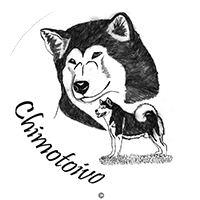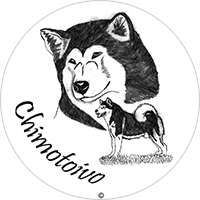Nature of the Alaskan Malamute
Affectionate, friendly, intelligent, obedient, good with children, good sled dog, social animal, but very quirky. Very big and strong. You need lots of patience and understanding in educating them, but also very consistently and vigorously. Malamutes can be very willful, and when they see no point in it, they certainly will not follow every command. There is a big difference in behavior between an individual dog and how they behave in pack. Any dog can be perfectly trained, when step in a pack, there is much more competition to be the alpha animal.
Behavior to other dogs
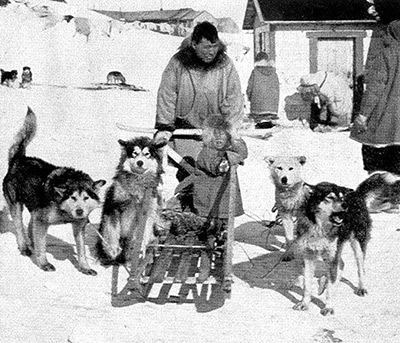 Malamutes their behavior towards other dogs is very clear: their body language can not be misunderstood. Despite the fact that they have to pull the sled with other dogs does not mean that they find other dogs nice and "cozy" to play. A good oriented socialization with different types of dogs: big, small, fluffy, bald, white or black is essential, but even then, conflicts with dogs of the same sex can't be avoided. The Malamute is incredibly big and strong, so his opponent will often get seriously injured or even killed in a confrontation. To indicate how strong they really are: there are several known cases where a Malamute has killed an adult Rottweiler and even an adult Rhodesian Ridgeback. An adult Malamute is generally not everybody's friend and the Malamute owner will have to prevent his dog from prooving his strength to other dogs. Since the Malamute will often win the fight he can become the scare of the neigborhood. As a puppy they still can gently play, but when they get to sexual maturity they consider other males as a serious competition. In practice, this means many Malamutes can not run loose in close proximity to other dogs and the owner needs to be strong.
Malamutes their behavior towards other dogs is very clear: their body language can not be misunderstood. Despite the fact that they have to pull the sled with other dogs does not mean that they find other dogs nice and "cozy" to play. A good oriented socialization with different types of dogs: big, small, fluffy, bald, white or black is essential, but even then, conflicts with dogs of the same sex can't be avoided. The Malamute is incredibly big and strong, so his opponent will often get seriously injured or even killed in a confrontation. To indicate how strong they really are: there are several known cases where a Malamute has killed an adult Rottweiler and even an adult Rhodesian Ridgeback. An adult Malamute is generally not everybody's friend and the Malamute owner will have to prevent his dog from prooving his strength to other dogs. Since the Malamute will often win the fight he can become the scare of the neigborhood. As a puppy they still can gently play, but when they get to sexual maturity they consider other males as a serious competition. In practice, this means many Malamutes can not run loose in close proximity to other dogs and the owner needs to be strong.
But Malamutes love to be in couples. Two dogs of the opposite sex is perfect and it's wonderful to enjoy the clear dog language. Or is it still wolves language?
Prey
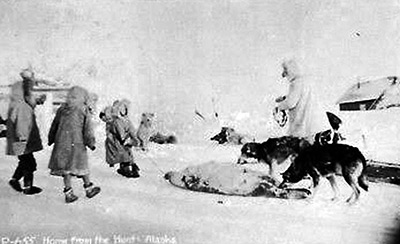 Other animals are prey. The survival instinct is very deeply rooted, as is the hunting instinct. Most breeds sometimes hunt cats or wildlife, Malamutes and Huskies behave more like a wolf. This means they hunt, kill and eat when they get the chance. Cats where he grew up with from childhood will be seen as pack mate, but strange cats don't. The cute bunny of the girl next door and the chickens from the farm in the street he sees as breakfast. With cattle and sheep you always need to pay attention! No need to say that when in a forest he sees or smells wild, he immediately want to go after it, and the command 'Here' doesn't work anymore. This is also one of the reasons why many Malamutes never run loose. Nevertheless he is, when he walks loose, less likely to roam than the Husky. He returns a little earlier...
Other animals are prey. The survival instinct is very deeply rooted, as is the hunting instinct. Most breeds sometimes hunt cats or wildlife, Malamutes and Huskies behave more like a wolf. This means they hunt, kill and eat when they get the chance. Cats where he grew up with from childhood will be seen as pack mate, but strange cats don't. The cute bunny of the girl next door and the chickens from the farm in the street he sees as breakfast. With cattle and sheep you always need to pay attention! No need to say that when in a forest he sees or smells wild, he immediately want to go after it, and the command 'Here' doesn't work anymore. This is also one of the reasons why many Malamutes never run loose. Nevertheless he is, when he walks loose, less likely to roam than the Husky. He returns a little earlier...
The thick and shaggy coat of the Malamute does not typically require any special care except during the moulting period. Once or twice a year, he replaces his hair for new and in those weeks, really nothing will be hairfree in your home, wardrobe and car. Because of this natural coat, Malamutes are pretty well able to adapt to the Belgian weather conditions. This allows them to be kept indoor and outside in the yard or large kennel. Malamutes are absolutely not yard fixed or loyal to the boss if he/she is out of sight, so good fencing of about 2 meters heigh (and preferably also some in the ground) is really necessary as outside the adventure is calling! At home he is a pleasant, quiet, sometimes lazy-looking dog. It's absolutely no nervous attention seeker when he gets provided enough exercise! When he doesn't get outdoors enough, he will find other activities: in the garden try to dig to Australia (or doesn't he like the plants?), transforming a sofa into a chair, the wallpaper wasn't very pretty, etc. And when he needs to stay home alone for too long, the whole neighborhood will get a nice concert. Because they are still true pack animals, they don't like to be alone for a long time, so they want everybody to hear where they are.
Difficult to raise?
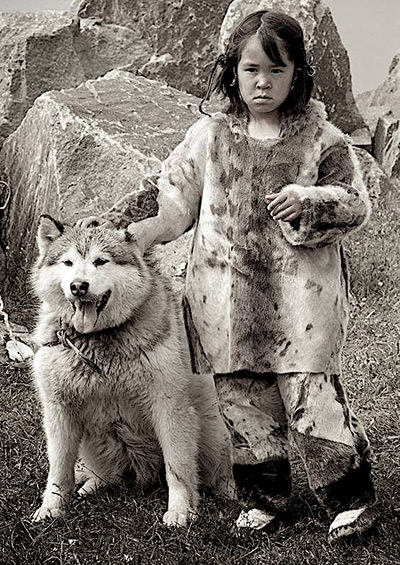 All dogs learn by association, this mainly concerns the association with the first time a dog show a certain behaviour: was it fun or not? Also Malamutes show this behaviour, only they are a little more inventive (some people may call it 'sneeky', because he knows so darn well when to make his move), and have some more primal instincts like hunting and gathering food. This means the owner of the Malamute has to be able to think ahead of his dog to prevent the dog is successful in his attempts.
All dogs learn by association, this mainly concerns the association with the first time a dog show a certain behaviour: was it fun or not? Also Malamutes show this behaviour, only they are a little more inventive (some people may call it 'sneeky', because he knows so darn well when to make his move), and have some more primal instincts like hunting and gathering food. This means the owner of the Malamute has to be able to think ahead of his dog to prevent the dog is successful in his attempts.
The Malamute likes to go out with people, and if it were up to him, sometimes likes to wander off on his own. Drudgery or naturally owner orientation, as you would for instance find with a shepherd is strange to a Malamute. He needs to learn as early as possible to pay attention to his owner. He needs to learn his owner is the boss and not the other way around. If this occasionally results in getting a reward (love goes through the stomach), the Malamute may do very well in obedience. The rumor that snowdogs can't learn anything is nonsense, it's just the owner who needs more commitment and perseverance (the sky is the limit!), then with the more boss targeted breeds and it is also a matter of the correct instructions.
Malamutes are not only able to use their feet very well, but also their head. Dogs often get more tired of mental acivitities, than of physical activities. Clicker training, obedience training, tracking and even skill training are fine activities for the Malamute. There are lots of Malamutes who make others stunned about their obedience.
How much exercise?
In the essence Malamutes are real working dogs. A daily walk around the block for him is simply not enough. For an adult dog, a few hours a day is better. A Malamute prefers an 'outdoor' owner who does many outdoor activities with his dog. When he can not be in front of a cart or sledge, then long walks, walk next to a bicycle or in front of a step, and a hiking trip is perfect for him, at least when the temperature is not too high (+/- 15°C).
The Malamute owner has the task to make sure his dog stays happy and healthy, by enough exercising and proper guidance. Only this shows the best of this beautiful dog, and it's an delight to live with them!
Children and the Malamute, the Malamute and children
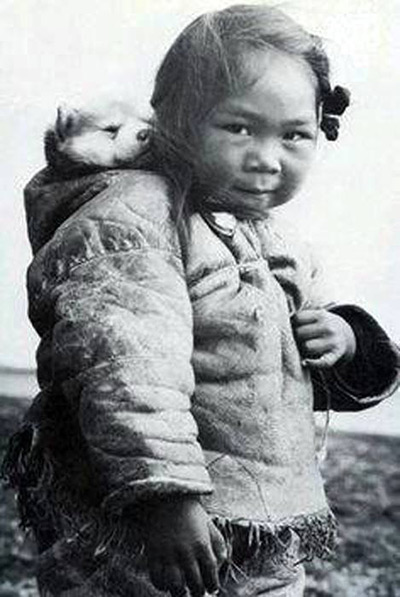 Malamutes have an average tolerance regarding children. But only when they were, as a puppy, good socialized with children and had no bad experiences. Children have to know the rules of behaviour and take them into account with every dog, this is the same as with the Malamute. This is why it's essential to never let a child alone with a dog. Malamutes are no suitable 'playmates', not only by their size and sometimes rudeness but also because they have totally different interests than children. You have to take into consideration Malamutes are mainly focused on feeding (they are after all related to wolves and want to survive). Especially in a household with small children, you have to be very alert, without malice nevertheless accidents may happen. Our puppies grow up with children so it's not an issue here.
Malamutes have an average tolerance regarding children. But only when they were, as a puppy, good socialized with children and had no bad experiences. Children have to know the rules of behaviour and take them into account with every dog, this is the same as with the Malamute. This is why it's essential to never let a child alone with a dog. Malamutes are no suitable 'playmates', not only by their size and sometimes rudeness but also because they have totally different interests than children. You have to take into consideration Malamutes are mainly focused on feeding (they are after all related to wolves and want to survive). Especially in a household with small children, you have to be very alert, without malice nevertheless accidents may happen. Our puppies grow up with children so it's not an issue here.
To unknown people, the Malamute behaves usually passive to active friendly. This means that his behavior towards strangers can range from fairly indifferent, ignoring ('if you don't have treats for me'), to an affectionate cuddle. He's definitely not bred to protect his boss or the possessions of his boss: a well socialized Malamute is almost never aggressive towards strangers. Despite his, for some, fearsome wolf-like appearance, visitors can just come in. Most Malamutes can not even bark. But there are very vocal types, who bawl and howl in all pitch to greet people. But when a Malamute has a bad feeling towards a person, or a person has bad intentions, he will protect his owner (pack). The Malamute appears in the Americas bite incidents list. Over a period of 10 years, there are 5 known cases where an adult was killed by a Malamute. This would concern strangers who had entered the grounds of the pack. Since there have been more bitinig incidents with other breeds, the Malamute is not on the list of dangerous breeds. But as the Malamute is strong, a biting incident will often lead to disastrous consequences.
But familiair people, especially those with whom he lives, may have to deal with his dominant characteristics. A Malamute has a very strong tendency to test the limits of its owners. When you are inconsistent or too indulgent, he will decide the rules for himself. He knows exactly where he can go. When an adult dog of about 40 to 50 kg finds out he can use aggression successfully, he is not to be underestimated. A Malamute should be educated very consitently and clear when he's very young, even when he's a cute and fluffy puppy at the age of 8 weeks old. This doesn't necessarily means he needs a hard hand, but he needs an owner with knowledge. Before purchase, immerse yourself in dog behavior, language and education. A Malamute owner should control his dog, physically and mentally. Once an adult, it's too hard to change his behavior.
The behavior of a purebred mainly depends on the purpose for which it was originally bred. In case of the Malamute, it's mostly work and survive under the harshest conditions. This still defines his current character: survival = me first and then comes you. It is a smart and strong dog.
The Malamute is not to compare with the more popular shepherds or retrievers and that is for a good reason: his temperament and the many primal instincts he still has, don't make him one of the easiest breeds. A Malamute owner should make every effort to properly educate and guide his dog. Because of the fact they don't live in a huge polar area, but in a densely populated area in which he will have to adapt.
The behavior of a Malamute can be understood from his previous tasks. Malamutes were working dogs, bred from the wild. Only since 1950, they are on a larger scale introduced as a pet. The Malamute in 2002 still exhibits the behavior associated with his original work, such as pulling heavy sleds. His original tasks concerned also the hunt. He hasn't forgotten this, and he shows a lot of dedication, a "killer instinct". This often makes it difficult to let him run loose.
